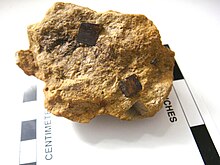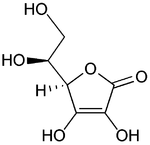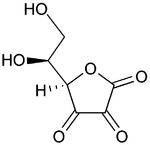Redox: Difference between revisions
Johnheritage (talk | contribs) No edit summary |
Johnheritage (talk | contribs) No edit summary |
||
| Line 9: | Line 9: | ||
<!-- do not add mnemonic devices or other memory tricks without discussing on talk page, (tough, I'm adding one anyway, since the talk page is a one sided, unrealistic, discussion) --> |
<!-- do not add mnemonic devices or other memory tricks without discussing on talk page, (tough, I'm adding one anyway, since the talk page is a one sided, unrealistic, discussion) --> |
||
A simple way of remembering this is the |
A simple way of remembering this is the mnemonic oilrig, 'Oxidation Is Loss, Reduction Is Gain'. |
||
Though sufficient for many purposes, these descriptions are not precisely correct. Oxidation and reduction properly refer to ''a change in oxidation number'' — the actual transfer of electrons may never occur. Thus, oxidation is better defined as an ''increase in oxidation number'', and reduction as a ''decrease in oxidation number''. In practice, the transfer of electrons will always cause a change in oxidation number, but there are many reactions that are classed as "redox" even though no electron transfer occurs (such as those involving [[covalent]] bonds). |
Though sufficient for many purposes, these descriptions are not precisely correct. Oxidation and reduction properly refer to ''a change in oxidation number'' — the actual transfer of electrons may never occur. Thus, oxidation is better defined as an ''increase in oxidation number'', and reduction as a ''decrease in oxidation number''. In practice, the transfer of electrons will always cause a change in oxidation number, but there are many reactions that are classed as "redox" even though no electron transfer occurs (such as those involving [[covalent]] bonds). |
||
Revision as of 21:36, 20 September 2010

Redox (shorthand for reduction-oxidation reaction) reactions describe all chemical reactions in which atoms have their oxidation number (oxidation state) changed.
This can be either a simple redox process, such as the oxidation of carbon to yield carbon dioxide (CO
2) or the reduction of carbon by hydrogen to yield methane (CH4), or a complex process such as the oxidation of sugar(C
6H
12O
6) in the human body through a series of complex electron transfer processes.
The term comes from the two concepts of reduction and oxidation. It can be explained in simple terms:
- Oxidation is the loss of electrons or an increase in oxidation state by a molecule, atom, or ion.
- Reduction is the gain of electrons or a decrease in oxidation state by a molecule, atom, or ion.
A simple way of remembering this is the mnemonic oilrig, 'Oxidation Is Loss, Reduction Is Gain'.
Though sufficient for many purposes, these descriptions are not precisely correct. Oxidation and reduction properly refer to a change in oxidation number — the actual transfer of electrons may never occur. Thus, oxidation is better defined as an increase in oxidation number, and reduction as a decrease in oxidation number. In practice, the transfer of electrons will always cause a change in oxidation number, but there are many reactions that are classed as "redox" even though no electron transfer occurs (such as those involving covalent bonds).
Non-redox reactions, which do not involve changes in formal charge, are known as metathesis reactions.


Oxidizing and reducing agents
In redox processes the reductant transfers electrons to the oxidant. Thus, in the reaction, the reductant or reducing agent loses electrons and is oxidized, and the oxidant or oxidizing agent gains electrons and is reduced. The pair of an oxidizing and reducing agent that are involved in a particular reaction is called a redox pair.
Oxidizers
Substances that have the ability to oxidize other substances are said to be oxidative or oxidizing and are known as oxidizing agents, oxidants, or oxidizers. Put another way, the oxidant removes electrons from another substance, and is thus itself reduced. And, because it "accepts" electrons, it is also called an electron acceptor.
Oxidants are usually chemical elements or substances with elements in high oxidation numbers (e.g., H
2O
2, MnO−
4, CrO
3, Cr
2O2−
7, OsO
4) or highly electronegative substances/elements that can gain one or two extra electrons by oxidizing an element or substance (O, F, Cl, Br).
Reducers
Substances that have the ability to reduce other substances are said to be reductive or reducing and are known as reducing agents, reductants, or reducers. That is, the reductant transfers electrons to another substance, and is thus itself oxidized. And, because it "donates" electrons, it is also called an electron donor. Electron donors can also form charge transfer complexes with electron acceptors.
Reductants in chemistry are very diverse. Electropositive elemental metals, such as lithium, sodium, magnesium, iron, zinc, aluminium, carbon, are good reducing agents. These metals donate or give away electrons readily. Hydride transfer reagents, such as NaBH4 and LiAlH4, are widely used in organic chemistry,[1][2] primarily in the reduction of carbonyl compounds to alcohols. Another method of reduction involves the use of hydrogen gas (H2) with a palladium, platinum, or nickel catalyst. These catalytic reductions are used primarily in the reduction of carbon-carbon double or triple bonds.
Examples of redox reactions
A good example is the reaction between hydrogen and fluorine in which hydrogen is being oxidized and fluorine is being reduced:
- H
2 + F
2 → 2 HF
We can write this overall reaction as two half-reactions:
the oxidation reaction:
- H
2 → 2 H+ + 2
e−
and the reduction reaction:
- F
2 + 2
e−
→ 2 F−
Analyzing each half-reaction in isolation can often make the overall chemical process clearer. Because there is no net change in charge during a redox reaction, the number of electrons in excess in the oxidation reaction must equal the number consumed by the reduction reaction (as shown above).
Elements, even in molecular form, always have an oxidation number of zero. In the first half-reaction, hydrogen is oxidized from an oxidation number of zero to an oxidation number of +1. In the second half-reaction, fluorine is reduced from an oxidation number of zero to an oxidation number of −1.
When adding the reactions together the electrons cancel:
H
2→ 2 H+ + 2
e−
F
2 + 2
e−
→ 2 F−
H
2 + F
2→ 2 H+ + 2 F−
And the ions combine to form hydrogen fluoride:
- H
2 + F
2 → 2 H+ + 2 F− → 2 HF
Displacement reactions
Redox occurs in single displacement reactions or substitution reactions. The redox component of these types of reactions is the change of oxidation state (charge) on certain atoms, not the actual exchange of atoms in the compounds.
For example, in the reaction between iron and copper(II) sulfate solution:
- Fe + CuSO
4 → FeSO
4 + Cu
The ionic equation for this reaction is:
- Fe + Cu2+ → Fe2+ + Cu
As two half-equations, it is seen that the iron is oxidized:
- Fe → Fe2+ + 2
e−
And the copper is reduced:
- Cu2+ + 2
e−
→ Cu
Other examples
- The oxidation of iron(II) to iron(III) by hydrogen peroxide in the presence of an acid:
- Fe2+ → Fe3+ + e−
- H2O2 + 2 e− → 2 OH−
- Overall equation:
- 2 Fe2+ + H2O2 + 2 H+ → 2 Fe3+ + 2 H2O
- The reduction of nitrate to nitrogen in the presence of an acid (denitrification):
- 2 NO3− + 10 e− + 12 H+ → N2 + 6 H2O

- Oxidation of elemental iron to iron(III) oxide by oxygen (commonly known as rusting, which is similar to tarnishing):
- 4 Fe + 3 O2 → 2 Fe2O3
- The combustion of hydrocarbons, such as in an internal combustion engine, which produces water, carbon dioxide, some partially oxidized forms such as carbon monoxide, and heat energy. Complete oxidation of materials containing carbon produces carbon dioxide.
- In organic chemistry, the stepwise oxidation of a hydrocarbon by oxygen produces water and, successively, an alcohol, an aldehyde or a ketone, a carboxylic acid, and then a peroxide.
Redox reactions in industry
The primary process of reducing ore to produce metals is discussed in the article on Smelting.
Oxidation is used in a wide variety of industries such as in the production of cleaning products and oxidising ammonia to produce nitric acid, which is used in most fertilizers.
Redox reactions are the foundation of electrochemical cells.
The production of compact discs depends on a redox reaction, which coats the disc with a thin layer of metal film.
Redox reactions in biology

|

|
Bottom: dehydroascorbic acid (oxidized form of Vitamin C)
Many important biological processes involve redox reactions.
Cellular respiration, for instance, is the oxidation of glucose (C6H12O6) to CO2 and the reduction of oxygen to water. The summary equation for cell respiration is:
- C6H12O6 + 6 O2 → 6 CO2 + 6 H2O
The process of cell respiration also depends heavily on the reduction of NAD+ to NADH and the reverse reaction (the oxidation of NADH to NAD+). Photosynthesis is essentially the reverse of the redox reaction in cell respiration:
- 6 CO2 + 6 H2O + light energy → C6H12O6 + 6 O2
Biological energy is frequently stored and released by means of redox reactions. Photosynthesis involves the reduction of carbon dioxide into sugars and the oxidation of water into molecular oxygen. The reverse reaction, respiration, oxidizes sugars to produce carbon dioxide and water. As intermediate steps, the reduced carbon compounds are used to reduce nicotinamide adenine dinucleotide (NAD+), which then contributes to the creation of a proton gradient, which drives the synthesis of adenosine triphosphate (ATP) and is maintained by the reduction of oxygen. In animal cells, mitochondria perform similar functions. See Membrane potential article.
The term redox state is often used to describe the balance of NAD+/NADH and NADP+/NADPH in a biological system such as a cell or organ. The redox state is reflected in the balance of several sets of metabolites (e.g., lactate and pyruvate, beta-hydroxybutyrate and acetoacetate), whose interconversion is dependent on these ratios. An abnormal redox state can develop in a variety of deleterious situations, such as hypoxia, shock, and sepsis. Redox signaling involves the control of cellular processes by redox processes.
Redox proteins and their genes must be co-located for redox regulation according to the CoRR hypothesis for the function of DNA in mitochondria and chloroplasts.
Redox cycling
A wide variety of aromatic compounds are enzymatically reduced to form free radicals that contain one more electron than their parent compounds. In general, the electron donor is any of a wide variety of flavoenzymes and their coenzymes. Once formed, these anion free radicals reduce molecular oxygen to superoxide, and regenerate the unchanged parent compound. The net reaction is the oxidation of the flavoenzyme's coenzymes and the reduction of molecular oxygen to form superoxide. This catalytic behavior has been described as futile cycle or redox cycling.
Examples of redox cycling-inducing molecules are the herbicide paraquat and other viologens and quinones such as menadione. [3]
Redox reactions in geology
In geology, redox is important to both the formation of minerals, mobilization of minerals, and in some depositional environments. In general, the redox state of most rocks can be seen in the color of the rock. Red is associated with oxidizing conditions of formation, and green is typically associated with reducing conditions. White (bleached rock) can also be associated with reducing conditions. Famous examples of redox conditions affecting geological processes include uranium deposits and Moqui marbles.
Balancing redox reactions
Describing the overall electrochemical reaction for a redox process requires a balancing of the component half-reactions for oxidation and reduction. For reactions in aqueous solution, this generally involves adding H+, OH−, H2O, and electrons to compensate for the oxidation changes.
Acidic media
In acidic media, H+
ions and water are added to half reactions to balance the overall reaction.
For example, when manganese(II) reacts with sodium bismuthate:
Unbalanced reaction: Mn2+
(aq) + NaBiO
3(s) → Bi3+
(aq) + MnO
4− (aq)Oxidation: 4 H
2O(l) + Mn2+
(aq) → MnO−
4(aq) + 8 H+
(aq) + 5
e−
Reduction: 2
e−
+ 6 H+
+ BiO−
3(s) → Bi3+
(aq) + 3 H
2O(l)
The reaction is balanced by scaling the two half-cell reactions to involve the same number of electrons (multiplying the oxidation reaction by the number of electrons in the reduction step and vice versa):
- 8 H
2O(l) + 2 Mn2+
(aq) → 2 MnO−
4(aq) + 16 H+
(aq) + 10
e− - 10
e−
+ 30 H+
+ 5 BiO−
3(s) → 5 Bi3+
(aq) + 15 H
2O(l)
Adding these two reactions eliminates the electrons terms and yields the balanced reaction:
- 14 H+
(aq) + 2 Mn2+
(aq) + 5 NaBiO
3(s) → 7 H
2O(l) + 2 MnO−
4(aq) + 5 Bi3+
(aq) + 5 Na+
(aq)
Basic media
In basic media, OH− ions and water are added to half reactions to balance the overall reaction.
For example, in the reaction between potassium permanganate and sodium sulfite:
Unbalanced reaction: KMnO
4 + Na
2SO
3 + H
2O → MnO
2 + Na
2SO
4 + KOHReduction: 3
e−
+ 2 H
2O + MnO
4− → MnO
2 + 4 OH−Oxidation: 2 OH− + SO
32− → SO
42− + H
2O + 2
e−
Balancing the number of electrons in the two half-cell reactions gives:
- 6
e−
+ 4 H
2O + 2 MnO
4− → 2 MnO
2 + 8 OH− - 6 OH− + 3 SO
32− → 3 SO
42− + 3 H
2O + 6
e−
Adding these two half-cell reactions together gives the balanced equation:
- 2 KMnO
4 + 3 Na
2SO
3 + H
2O → 2 MnO
2 + 3 Na
2SO
4 + 2 KOH
See also
- Organic redox reaction
- Hydrogenation
- Bessemer process
- Bioremediation
- Calvin cycle
- Citric acid cycle
- Electrochemical cell
- Electrochemistry
- Chemical looping combustion
- Electrolysis
- Electrochemical series
- Galvanic cell
- Membrane potential
- Oxidative addition and reductive elimination
- Pro-oxidant
- Reducing agent
- Thermic reaction
- Partial oxidation
- Reduction potential
- Chemical equation
- Reduced gas
References
- ^ Hudlický, Miloš (1996). Reductions in Organic Chemistry. Washington, D.C.: American Chemical Society. p. 429. ISBN 0-8412-3344-6.
- ^ Hudlický, Miloš (1990). Oxidations in Organic Chemistry. Washington, D.C.: American Chemical Society. p. 456. ISBN 0-8412-1780-7.
- ^ Template:PDFlink
- Schüring, J., Schulz, H. D., Fischer, W. R., Böttcher, J., Duijnisveld, W. H. (editors)(1999). Redox: Fundamentals, Processes and Applications, Springer-Verlag, Heidelberg, 246 pp. ISBN 978-3540665281 (pdf 3,6 MB)
External links
- Chemical Equation Balancer - An open source chemical equation balancer that handles redox reactions.
- Video - Synthesis of Copper(II) Acetate 20 Feb. 2009
- Redox reactions calculator
- Redox reactions at Chemguide
- Online redox reaction equation balancer, balances equations of any half-cell and full reactions
